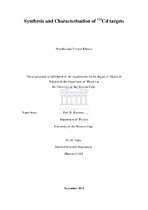| dc.contributor.advisor | Knoesen, D. | |
| dc.contributor.author | Kheswa, Ntombizonke Yvonne | |
| dc.date.accessioned | 2014-09-23T11:11:55Z | |
| dc.date.available | 2014-09-23T11:11:55Z | |
| dc.date.issued | 2011 | |
| dc.identifier.uri | http://hdl.handle.net/11394/3681 | |
| dc.description | >Magister Scientiae - MSc | en_US |
| dc.description.abstract | To study nuclear reactions and nuclear structures, target materials are bombarded with high-energy particles. The target material can either be in a form of a metal film or gas. A target material designed to study certain nuclear reactions or to produce nuclei to study their structure should yield as minimum as possible of competing reactions under ion bombardment. This requires a chemically and isotopically pure target material prepared as a self supporting thin film, or as alternative, prepared on a thin career foil. Additional requirement for lifetime measurement experiments are homogeneity and precise thickness of the target material. Some of the data obtained from the stopping power experiment where targets of 114Cd were used for lifetime measurement are presented. Moreover, a nuclear target should influence the spectroscopic resolution as little as possible. Thus, film thickness must be adjusted to the respective reaction under study while observing the optimum thickness homogeneity. | en_US |
| dc.language.iso | en | en_US |
| dc.subject | Nuclear targets | en_US |
| dc.subject | Target thickness | en_US |
| dc.subject | Characterization | en_US |
| dc.subject | Rutherford backscattering | en_US |
| dc.subject | Particle induced X-ray emission | en_US |
| dc.subject | X-ray diffraction | en_US |
| dc.subject | Atomic force microscopy | en_US |
| dc.subject | Scanning electron microscopy | en_US |
| dc.subject | Rolling method | en_US |
| dc.subject | Vacuum deposition | en_US |
| dc.title | Synthesis and characterisation of 114Cd targets | en_US |
| dc.type | Thesis | en_US |

